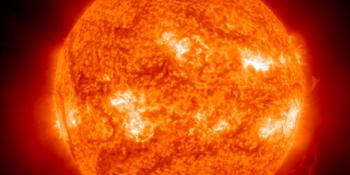Prohlížíte si archiv středa 12. června 2002
Report sluneční aktivity
Každá zmíněná sluneční erupce v této zprávě má škálovací faktor aplikovaný Střediskem předpovědi kosmického počasí (SWPC). Kvůli škálovacímu faktoru SWPC jsou sluneční erupce hlášeny jako o 42 % menší než u údajů o vědecké kvalitě. Z našich archivovaných dat slunečních erupcí byl odstraněn faktor měřítka, aby odrážel skutečné fyzikální jednotky.
Zpráva o sluneční-geofyzikální činnosti 2002 Jun 12 2200 UTCPřipraveno NOAA © SWPC a zpracováno SpaceWeatherLive.com
Společná zpráva USAF / NOAA o sluneční a geofyzikální činnosti
SDF číslo 163 Vydáno za 2200Z za 12 Jun 2002IA. Analýza solárních aktivních oblastí a aktivity od 11-2100Z do 12-2100Z Solar activity was at low levels. Optically verified
using EIT imagery, Region 9987 (S15W56) produced a C1 x-ray flare at
12/0903 UTC. This region underwent slight decay today. Less
penumbral coverage seen in trailing cluster of spots, although
region continues to exhibit beta-gamma magnetic characteristics.
Region 9991 (S22E04) showed slight growth in penumbral coverage
during the period. Other than occasional point brightening and
minor dark surging, this region was stable through the period. A
Type II radio sweep with an estimated shock velocity of 450 km/s
occurred at 12/0145 UTC. Source region of the sweep is believed to
have originated from beyond the northeast limb of the visible disk.
Regions 9996 (S27E46), 9997 (N08E73), and 9998 (N15E74) were
numbered today.
IB. Předpověď sluneční aktivity
Solar activity is expected to be at
low levels. Region 9987 remains capable of producing an isolated
low level M-class flare.
IIA. Souhrn geofyzikální aktivity 11-2100Z až 12-2100Z
The geomagnetic field activity was at quiet to unsettled levels.
IIB. Předpověď geofyzikální aktivity
The geomagnetic field activity
is expected to continue at quiet to unsettled levels. Day three of
the forecast period may experience isolated active conditions in
response to a southern hemispheric high speed stream coronal hole
becoming favorably positioned.
III. Pravděpodobnosti události 13 Jun až 15 $ 4
| Třída M | 25% | 25% | 25% |
| Třída X | 01% | 01% | 01% |
| Proton | 01% | 01% | 01% |
| PCAF | green | ||
IV. Proud Penticton 10.7 cm
Pozorováno 12 Jun 142 Předpovězeno 13 Jun-15 Jun 145/145/155 90 denní průměr 12 Jun 180
V. Geomagnetické indexy A
Pozorováno Afr/Ap 11 Jun 007/012 Odhadovaný Afr/Ap 12 Jun 005/010 Předpovězeno Afr/Ap 13 Jun-15 Jun 005/008-006/008-010/010
VI. Pravděpodobnosti geomagnetické aktivity 13 Jun až 15 Jun
| A. Střední zeměpisné šířky | |||
|---|---|---|---|
| Aktivní | 10% | 10% | 20% |
| Menší bouře | 01% | 01% | 10% |
| Silná bouře | 01% | 01% | 01% |
| B. Vysoké zeměpisné šířky | |||
|---|---|---|---|
| Aktivní | 15% | 15% | 25% |
| Menší bouře | 05% | 05% | 10% |
| Silná bouře | 01% | 01% | 01% |
Všechny časy v UTC
<< Přejít na stránku s denním přehledem
Poslední zprávy
Nejnovější zprávy na fóru
AR 3959 34Comet C/2024 G3 (ATLAS) in LASCO C3 13IP cameras for sky surveillance 43Mars occultation 4Notification red dot on app icon in dock 4
Další témataPodpora SpaceWeatherLive.com!
Mnoho lidí přichází do SpaceWeatherLive, aby sledovali aktivitu Slunce nebo pokud je vidět polární záři, ale s větším provozem přicházejí i vyšší náklady na server. Zvažte dar, pokud vás baví SpaceWeatherLive, abychom mohli udržovat web online!

Fakta o počasí ve vesmíru
| Poslední X-záblesk | 04. 01. 2025 | X1.85 |
| Poslední M-záblesk | 09. 01. 2025 | M1.1 |
| Poslední geomagnetická bouře | 04. 01. 2025 | Kp5 (G1) |
| Dny bez skvrn | |
|---|---|
| Poslední den bez skvrn | 08. 06. 2022 |
| Průměrný měsíční počet slunečních skvrn | |
|---|---|
| prosince 2024 | 154.5 +2 |
| ledna 2025 | 137.6 -16.9 |
| Posledních 30 dnů | 152.2 +35.1 |


